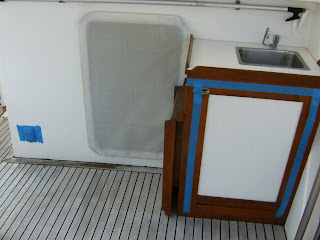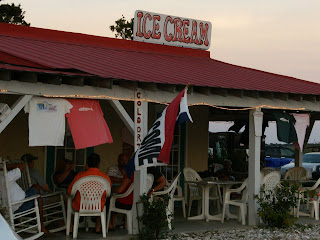 Since the day we closed the deal on Maya, there have been two issues that have been at the back of my mind and of great bother to me.
Since the day we closed the deal on Maya, there have been two issues that have been at the back of my mind and of great bother to me. Taxes and registration.
Without going into all of the legal mumbo jumbo, buying a boat out of state and moving it from jurisdiction to jurisdiction brings up all kinds of taxation and registration issues. The laws vary from state to state and there is no clear guidance on whom to pay taxes to or how much. Over the past year, I literally spent weeks on the phone and internet trying to figure out what we should do. I called the tax department in every state we transited as well as those we planned to visit in the future. As you might have guessed, I got different answers from every official I spoke with.
Florida has the most onerous restrictions and since we were going to be there for about a year, I decided that I had better comply with their rules just to be on the safe side. As they say, it is better to ask for forgiveness than permission. With that in mind, I visited the State of Florida department of Taxation and Revenue while down in Naples last week.

Before I go on, I should say for the record that I have the upmost respect and compassion for all of the good folks who work for the state of Florida. Theirs is a thankless job and I certainly would not like to work on their side of the plate glass window, but just once, I would like to be shown the courtesy and consideration customers should receive when they are forking over a large number of boat units.
Whoever designed the offices of the Florida Department of Revenue did not have the customer in mind. The plate glass window I spoke of has a small hole that you must speak through in order to be heard by the agent. This small hole is placed about four feet off the floor, so every time you want to talk you have to bend over, crank your head to one side and loudly state your case. I was wondering what kind of numbskull would devise such a system when it dawned on me that the height of the hole was there for the benefit of the agent. She sits all day and it is at perfect mouth level for her. But I digress.
I think the agent I dealt with knew right away that my situation was not going to be the standard car/license plate transaction they deal with most of the time. I was a non-resident, I had a boat (2 if you count the dinghy), the boat was documented by the U.S. Coast Guard and was bought out of state, there was a long line behind me and it was ten minutes till lunch. The perfect storm.
I thought I would try the 'lost puppy' routine on her to see if I could get past her air of indifference. You know the lost puppy routine. Act like you are totally lost and helpless, smile a lot and beg for any breaks that can be sent your way. This used to work well for me, especially when I was younger. I think now that I am without hair and generally irrelevant, I need to come up with a better schtick. I am not fooling anybody anymore.
I could tell in the first thirty seconds that she was not a dog lover of any kind and could care less about lost puppies, lost kittens or out of state boat owners. Her job was to get rid of me as quickly as possible as the noon hour approached. So much for the lost puppy routine. I decided to go for the more direct approach.
Bending down and leaning to one side, I told her that, "I had been in contact with the Department of Taxation in Tallahassee and they gave me a list of the documentation I needed to process my application for registration and title." I added, "I wanted to be prepared so we can do this as quickly as possible and so I won't waste your time." Raising one eyebrow (her only one as a matter of fact), I could tell immediately that she would be the judge of that.
One by one, she picked off all the documents that I needed. Like a machine, I presented each and every one according to her request, properly filled out and notarized. "Do you have Florida form 2271-A?" she asked? "Yep, right here," I said. "Damn" she must of thought, "this guy is good."
"Do you have a pencil tracing of the registration plate of the dinghy? I will need that you know...." "Of course," I said. As I slid the paper under the glass window, I saw some of the lilt go out of her eyebrow. "So you want to play hardball, do you sonny!" I could imagine her thinking.
But, she couldn't get me. Whatever she wanted, I had it... copies and all. Seventeen pieces of paper flew between the two of us. It was going to be a duel to the finish. She was just about out of cards when she said, "I will need your wife to sign this form. She is here isn't she?" As I swallowed hard and the color drained from my face, I meekly muttered "no." "Well come back when she is with you" was all she said as she closed her window and gave me that wry smile we all know too well.
Luckily Kim was not far away and by the time we got back, lunch was over. The agent had made her point, though. The victory was hers and we both knew it. From there on out, the process went very fast and after writing a boat unit sized check to the Commonwealth of Florida, I left with two yellow stickers the size of a postage stamp. "Make sure you stick these in the appropriate place," was her parting shot.
If only I could.























 I couldn't leave the bridge to look for her so the first thing I did was yell. I knew that probably wasn't going to work as the engines are noisy and you can't hear much while underway. Even if she did hear me, I doubt if she would come running as, well.... we have been married almost 25 years and that kind of thing just doesn't happen anymore.
I couldn't leave the bridge to look for her so the first thing I did was yell. I knew that probably wasn't going to work as the engines are noisy and you can't hear much while underway. Even if she did hear me, I doubt if she would come running as, well.... we have been married almost 25 years and that kind of thing just doesn't happen anymore. 

 The next day found us in Southport, North Carolina, Maya's previous home port. Roger and Cathy Tatum, the couple from whom we purchased Maya, still live there and we took the opportunity to meet them for dinner. They are a delightful pair who still have a soft spot in their hearts for Maya. We spent the evening listening to stories of their cruising adventures. It was really a treat. Of course, I had to have some ice cream afterwards. When it is hot out, it just tastes so good.
The next day found us in Southport, North Carolina, Maya's previous home port. Roger and Cathy Tatum, the couple from whom we purchased Maya, still live there and we took the opportunity to meet them for dinner. They are a delightful pair who still have a soft spot in their hearts for Maya. We spent the evening listening to stories of their cruising adventures. It was really a treat. Of course, I had to have some ice cream afterwards. When it is hot out, it just tastes so good.



















